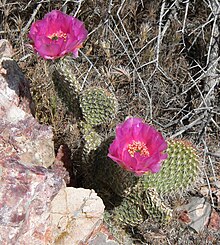Opuntia polyacantha
| Opuntia polyacantha | |
|---|---|

| |
| Scientific classification | |
| Kingdom: | Plantae |
| Clade: | Tracheophytes |
| Clade: | Angiosperms |
| Clade: | Eudicots |
| Order: | Caryophyllales |
| Family: | Cactaceae |
| Genus: | Opuntia |
| Species: | O. polyacantha
|
| Binomial name | |
| Opuntia polyacantha | |
Opuntia polyacantha is a common species of cactus known by the common names plains pricklypear,[1][2] hairspine cactus,[1] panhandle pricklypear,[3] and starvation pricklypear.[4] It is native to North America, where it is widespread in Western Canada, the Great Plains, the central and Western United States, and Chihuahua in northern Mexico.[3][4]
This cactus grows in a wide variety of habitat types, including sagebrush, Ponderosa pine forest, prairie, savanna, shrublands, shrubsteppe, chaparral, pinyon-juniper woodland, and scrub.[1]
Description[]
Opuntia polyacantha grows up to 4–12 in (100–300 mm) tall. It forms low mats of pads which may be 2–3 m (6+1⁄2–9+7⁄8 ft) wide.[1] Its succulent green pads are oval or circular and reach 27 by 18 cm (10+5⁄8 by 7+1⁄8 in) wide. Its areoles are tipped with woolly brown fibers and glochids. Many of the areoles have spines which are quite variable in size and shape. They may be 0.4 to 18.5 cm (1⁄8 to 7+1⁄4 in) in length, stout or thin, straight or curling, and any of a variety of colors.
The flowers are 2.5 to 4 cm (1 to 1+5⁄8 in) long and may be yellow or magenta in color. The fruit is cylindrical, brownish, dry and spiny.[4] The cactus reproduces by seed, by layering, and by resprouting from detached segments.[1] In its natural range it survives throughout an immense range of temperatures, ranging from −46 °C (−50 °F) in the Yukon Territory, Canada,[5] to well above 38 °C (100 °F) in places like Chihuahua, Mexico.
There are many expressions of O. polyacantha and variation is common. Multiple varieties have been proposed. Some are accepted by modern authorities and some require further study.[6]
Uses[]
Native Americans used it as a medicinal plant, with different parts treating various symptoms.[7]
This pricklypear provides food for many types of animals. It provides over half the winter food for the black-tailed prairie dog in one area. Pronghorn antelope eat it, especially after the spines are burned off in wildfires. Ranchers intentionally burn stands of the plant to make it palatable for livestock when little other food is available. It will also grow in waste areas where good forage will not take hold. In fact, an abundance of the cactus indicates land that is poor in quality.[1]
Several insects attack the cactus, including the cactus moth Melitara dentata, the blue cactus borer Olycella subumbrella, and the cactus bug Chelinidea vittiger.[1]
O. polyacantha provided the Lewis and Clark Expedition with opportunity for admiration and more often complaint about the plant.[8]
With the skin and seeds removed, the fruit can be eaten raw or made into candy.[9]
References[]
- ^ Jump up to: a b c d e f g Johnson, K. A. 2000. Opuntia polyacantha. In: Fire Effects Information System, [Online]. U.S. Department of Agriculture, Forest Service, Rocky Mountain Research Station, Fire Sciences Laboratory (Producer). Retrieved May 11, 2011.
- ^ Opuntia polyacantha. USDA Plants Profile. Retrieved May 11, 2011.
- ^ Jump up to: a b Opuntia polyacantha. The Nature Conservancy. Retrieved May 11, 2011.
- ^ Jump up to: a b c Opuntia polyacantha. Flora of North America. Retrieved May 11, 2011.
- ^ Linn, Alan (September–October 1972). "What Can You Expect from the World's Greatest Misers?". International Wildlife. 2 (5): 36–38.
- ^ "Opuntia polyacantha at Opuntia Web".
- ^ University of Michigan - Dearborn: Native American Ethnobotany (Opuntia polyacantha)
- ^ http://www.lewis-clark.org/article/3121
- ^ Niering, William A.; Olmstead, Nancy C. (1985) [1979]. The Audubon Society Field Guide to North American Wildflowers, Eastern Region. Knopf. p. 437. ISBN 0-394-50432-1.
External links[]
| Wikimedia Commons has media related to Opuntia polyacantha. |
- NatureServe secure species
- Opuntia
- Cacti of Canada
- Cacti of Mexico
- Cacti of the United States
- Flora of the Great Plains (North America)
- Flora of the Southwestern United States
- Flora of the Northwestern United States
- Flora of Western Canada
- Flora of California
- Flora of the California desert regions
- Flora of Chihuahua (state)
- Flora of New Mexico
- Flora of the Sierra Nevada (U.S.)
- Flora of Texas
- Natural history of the Mojave Desert
- Plants used in traditional Native American medicine
- Plant dyes

